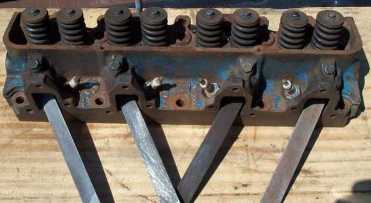
Exhaust Port Angles
Before we can talk about manifold and header design we need to understand just what environment they are working in.
Headers receive the exhaust gases from the exhaust port on the head. These gases are hot, low pressure pulses. The fuel air mixture burns and pushes the piston with pressure of up to 800 to 1000 pounds near top dead center. This pressure drops as the piston moves down. As a rule of thumb divide by the compression ratio so at a 10:1 compression the drop is to 80 - 100 pounds when the piston is a the bottom of its stroke if we ignore the exhaust valve's opening. Which we can't as I will now explain.
When the valve opens, usually around 70 degrees before bottom dead center, the pressure bleeds off rapidly. At around 10 degrees before bottom dead center the valve is open around .050 of an inch. The valve needs to be open this much for any real volume of exhaust gas to move past it. But the pressure has largely bleed off dropping to less than 15 pounds (at wide open throttle at the RPM range where peak torque is produced) and perhaps as little as 5 pounds at idle.
Now the piston is ready to start its upward trip and to push the bulk of the exhaust gases out of the cylinder. Near the top of the stroke the exhaust valve starts to close dropping below the .050 value just before the piston actually gets to the top of the stroke, somewhere around 15 degrees before top dead center.
So we have a burst of low to moderate pressure gases followed by a relatively low pressure pulse of exhaust gases that gets pushed out of the cylinder by the piston.
Lets look briefly at the FE head and its exhaust port design.

Exhaust Port Angles
The first picture, above, shows an FE head with flat files sticking out of the exhaust ports at the angle the exhaust gases would take. Note that they point toward the center with the left two pointing toward the right two.

'76 360 Truck Right Exhaust Manifold
The picture above shows the common FE "log" manifold. This one is off a '76 Truck 360 engine. Note the rear exit. This manifold is typical of those found on the FE engine.
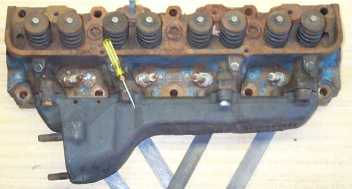
'76 360 Truck Right Exhaust Manifold Flow Restriction
The second picture of this manifold shows how the gas flows from the front cylinder past the second cylinder and that the third cylinder is directed right at the point where the exhaust gas from the front cylinders is coming from, causing a lot of turbulence. The gas from the rear or cylinder 4 has to move forward then make a sharp turn to the rear to go out the exit. There is almost nothing good about this manifold.

'76 360 Truck Left Exhaust Manifold
The right exhaust manifold off the same '76 360 engine is shown above. Note the this is for the other side of the engine so it exits to the right. It has a near center exit and none of the ports point at another. This is a much better design.
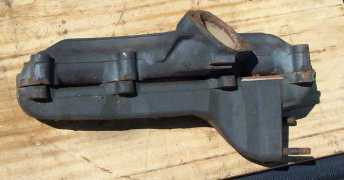
Both '76 360 Truck Manifolds
This picture shows these two truck manifolds belly-to-belly. The advantages of the center exit manifold are obvious. I have seen the left manifold used on both sides and it is easy to understand why.

Typical 390-406 Police Interceptor Manifold
Pictured above is a Police Interceptor manifold from 1962. It was used on high performance 390 and 406 engines. This is the left side; the right side is similar. This is referred to as a "shorty" header and is a very good design.. No ports are directed at another. The gases leaving do not have to make any sharp or short turns. The left manifold is similar.
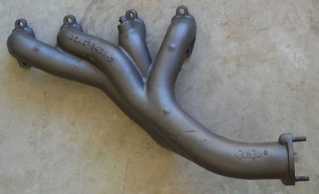
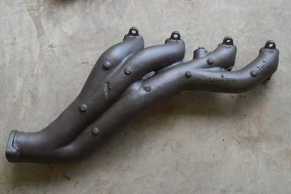
Typical 427 Big Car Manifolds '63-'64
The above pictures are of the Ford 427 '63-64 factory cast iron headers used in the Galaxie body. Its is a full length header. The style is called Tri-Y because two sets of the cylinders are "Y"ed or paired together and the third "Y"ing is when those two pipes meet at the bottom of the manifold. This is an excellent design. Tri-Y headers are know for the improvement they make in low and mid range torque.
Changing from the "log" manifold to a Tri-Y is worth 30 to 60 horsepower and is the single most important change you can make to the Ford FE engine.
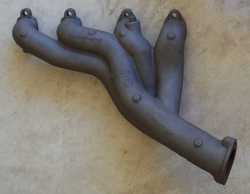
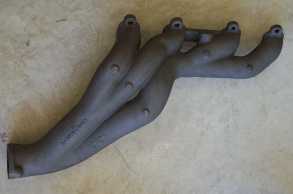
Typical 427 Big Car Manifolds '65-'68
These are the 427 manifolds for used in the '65-'68 Galaxies. Neither look as free flowing and the earlier ones. The right side one is pinched back to clear the frame and the left one is routed a bit differently for the rear, No. 8, port.
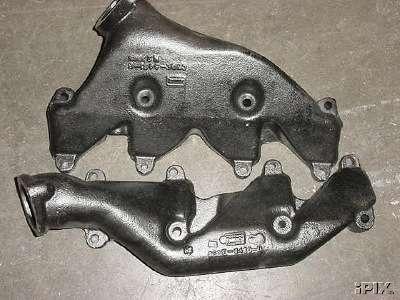
'66 Fairlane 427 Exhaust Manifolds
The above picture shows the original '66 Fairlane 427 manifolds. It is the only one I have been able to find of these. I have never seen these manifolds and they are very rare and expensive. Notice that the passenger side manifold does not appear to be very good. The rear two ports forcing the gases to make that tight turn to the back; the spring tower on the '66 unibody Fairlane is hard to work with.
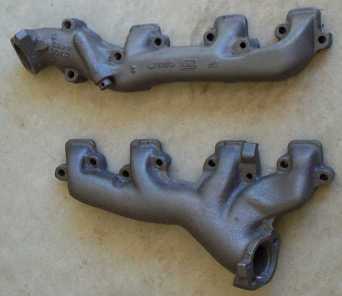
390GT Exhaust Manifolds
The above picture are of the typical 390GT manifolds used on Fairlanes and Comets 1966 through 1969. They were also used on the '67-'69 Mustnags and Cougars. While the left side is just fine the right one (top) is not much better than the log style. Remember that the exhaust gases exiting cylinder 4 is angled forward so where that port merges into the rest of the manifold is high turbulence point. And remember the heads were the drop port design which didn't help either. There does not appear to be a lot of difference between the right one here and the corresponding 427 one above.
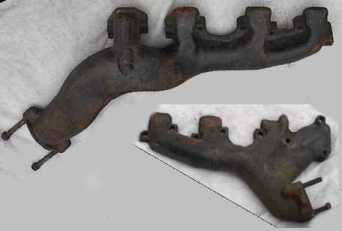
428 Cobra Jet Exhaust manifolds
Above is the last high performance manifold set head made by Ford for the FE. These are the 428 CJ manifolds for the '68 and '69 Mustangs, Cougars and Torinos. The right manifold is on top. Actually not anywhere near as good as the Police Interceptor shorty manifolds. But the right side CJ manifold is much better than both the stock "log" manifold, the GT manifold and possibly the '66 427 Fairlane manifold. The left manifold is very similar to the GT manifold. Note that these will fit the '65-'68 Galaxies.
Almost any of the left side manifolds are fine; it's the right side that is the problem. And while the left side has a number of good manifolds, for the right side only the CJ and PI shorty and 427 Tri-Y offer decent performance.
I haven't run all of these manifolds on a dyno so these numbers are my estimates. Changing from the stock" log" to a shorty header is worth 20 to 40 horsepower depending on the size of your engine and is the single most important change you can make to the Ford FE engine if you want to improve performance or gas mileage. Changing from the "log" manifold to a Tri-Y is worth 30 to 50 rear wheel horsepower.
For the street and especially for trucks any Tri-Y offers the best improvement by increasing low to mid range torque. This is where most of us drive 90%+ of the time and while the equal length header is very impressive those that know better look for a set of Tri-Ys. After market shorty headers are fine also and easier to install and less expensive. The traditional 4 long tube header is fine and the type best if you race.